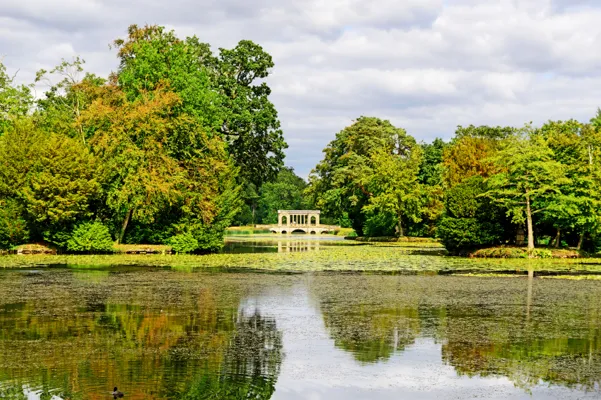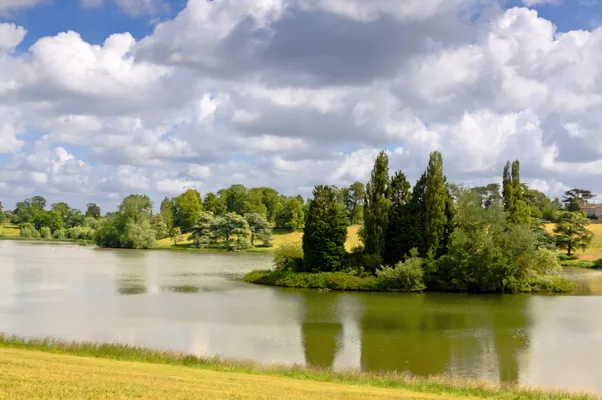At the peak of his career in the 1750s, Lancelot Brown was the toast of the aristocracy. Acknowledged as the greatest landscape gardener of his generation, he was in huge demand, repeatedly crossing on horseback, visiting some of England's richest and most powerful people to check progress on dozens of ambitious landscaping projects. Poet William Cowper wrote in mock awe: The omnipotent magician, Brown, appears, He speaks. The lake in front becomes a lawn, woods vanish, hills subside, and valleys rise.
So popular was Brown, and so widespread the impact of his work, that author Richard Owen Cambridge is said to have professed his desire to die before Brown - so he could "see heaven before it was 'improved'". Brown's rise was particuarly spectacular, given his relatively humble origins. He began life in Kirkhale, Northumberland, the son of a land agent and a chambermaid. During his teens he worked as a gardener for Sir William Loraine's estate, of which his father was steward.
Yet these formative years laid the ground for Brown's future success. Soon he had learned the basic skills of building and land management, proving himself highly competent. Showing an unusual combination of creative vision, practicality and organisational skills, he could both design and project-manage. Just as significantly, Brown could think quickly, turning out new designs fast, and on a grand scale. Soon he began consulting on other estates nearby.
Natural Talent
When Brown moved south in 1741, his work was noticed by Lord Cobham at Stowe in Buckinghamshire, one of the most famous gardens in England. He joined Cobham's staff and soon became head gardener, tasked with implementing the earlier designs of the landscape gardener William Kent and architect James Gibbs, and he rapidly absorbed their ideas.

Lord Cobham loaned Brown's landscaping talents to close friends, and his reputation burgeoned. In 1750 he began working independently, eventually lending his talents to more than 170 gardens across Britain.
Brown's first major parkland commission came in 1751, when the fashionable 6th Earl of Coventry, who had inherited his estate aged 28, asked him to redesign both the landscape and house at Worcestershire's Croome Court. Coventry wanted the new-look estate to be at the forefront of contemporary design; so Brown swept away the formal garden and drained the surrounding marshy parkland. He channelled the water into a new lake and a river that appeared to meander off into the distance (actually it came to an abrupt halt behind a perfectly placed clump of trees). He planted a shrubbery walk punctuated by follies and temples, and even moved and rebuilt a village to enhance a view.
There was also an impressive tree collection, said to be second only to Kew's. Many of the trees he planted have survived, thoug many are now over-mature. Over the past decade, the National Trust, custodian of Croome, has planted 10,000 trees there, often using GPS to ensure they are planted according to his 18th century plan.
In 1754 Brown began another triumphant transformation: creating a masterplan to improve the house and grounds for the 9th Earl of Exeter at Burghley in Linconshire, which took more than 25 years to complete. Brown dammed a stream to form a lake, and added several new buildings. One of only two portraits of Brown hangs in the Pagoda room.
Three years later he started work at Longleat. Soon the formal garden had disappeared, while the garden, terrace park and lakes were modified and extensive plantations added - 91,000 trees were planted during one winter.
Honest Lancelot
Brown's personal conduct added to his reputation. He was businesslike, industrious and honest. He once even returned an extra payment from a client, saying the sum agreed had been sufficent. Another client found him "an agreeable, pleasant companion, as well as a great genius in his profession". He was an entertaining dinner guest and became respected and well connected, becoming friends with William Pitt, George III and actor David Garrick. Brown soon became fashionable and the 'must-have' landscape improver and place-maker to the aristocracy. His client list included dukes and duchesses, six prime ministers and half of the House of Lords.
Such were Brown's skills that his commissions varied. Some clients wanted him to landscape their whole estate or design or make improvements to their house; others asked him to work his magic over just part of the grounds. In 1758, Jemima, Marchioness de Grey, invited him to display his talents at Wrest Park, Bedfordshire. As the de Greys had employed some of the greatest names in British landscape design, including William Chambers and Nicholas Hawksmoor, Brown's contribution was confined to the perimeter, where he created a serpentine lake. Brown had so many projects running concurrently that by the end of the 1750s he had more than 20 foremen on his books.
In 1760 he began working at Chatsworth for the 4th Duke of Devonshire. There was no need to create an artificial 'river', so he merely widened and altered the course of the River Derwent instead. Ponds and parterres were converted to rolling lawns, valleys sculpted and, as he often did, large trees transplanted alongside smaller specimens for instant impact. One of the most magnificent examples of his work is at Blenheim Palace, Oxfordshire, with two lakes and a great cascade at its western perimeter. Such projects meant employing huge numbers of workers to shift thousands of tons of soil by hand. [See the results for yourself at this year's Countryfile live show].

One of Brown's last commissions, from the 4th Duke of Rutland at Belvoir Castle, arrived in 1780, just before he died. The plans were never fully implemented and were recently rediscovered; the landscape is now being transformed by the current Duchess of Rutland and her team.
Brown collapsed and died suddenly from a seizure on 6 February 1783, after an evening dining hosted by Lord Coventry, owner of Croome court. He was buried in Fenstanton where he was Lord of the Manor.
By the time he died, his ideas were so influential that some 4,000 gardens had been landscaped according to his principles. And his style influenced the designs of parks and gardens from Europe to Russia. His memorial in Fenstanton church sums up the life of the astonishing Mr Brown, declaring: "More than genius slumbers here".
Matthew Biggs lectures, writes and broadcasts about gardening. His books include Lessons from Great Gardeners: Forty Gardening Icons and What They Teach Us (RHS, 2015). Matthew is a regular expert panelist on Gardener's Question Time on BBC Radio 4, broadcast on Fridays at 3pm, repeated on Sundays at 2pm.
Photo credits: ©iStockphoto.com
